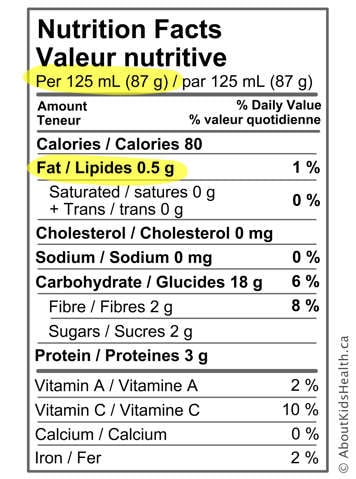Why is fat important?
Fat is an essential part of your child or teen’s diet. It plays an important role in the development of your child’s brain and helps them reach their maximum growth potential. Fat is used in the body as fuel and helps the body absorb the fat-soluble vitamins, A, D, E and K.
Fatty foods are often associated with overweight, obesity, heart disease and stroke, but eating the right fats can provide the body with many health benefits.
Types of fat
Unsaturated fat
Unsaturated fats are considered to be the healthiest fats. They include polyunsaturated and monounsaturated fats. They are important for brain, nerve and eye development in infants. They have also been shown to decrease risk of heart disease and stroke because they increase the “good” HDL cholesterol in the blood.
Great sources of unsaturated fats include salmon, nuts, seeds, canola oil, olive oil, soft non-hydrogenated margarine and avocado.
Saturated fat
Saturated fats are found mostly in meat and animal products. They help packaged foods stay fresh longer and give baked goods a smooth texture. Saturated fats may increase the risk of heart disease and stroke because they raise the “bad” LDL cholesterol in the blood.
Sources of saturated fats include coconut oil, cheese, fatty cuts of meat, hard hydrogenated margarine and butter.
Trans fat
Trans fats are considered to be the least healthy fat. They raise the “bad” LDL cholesterol and decrease the “good” HDL cholesterol in the blood, which can lead to heart disease and stroke. Along with saturated fats, trans fats help to increase the shelf life of packaged foods and give baked goods that “melt in your mouth” feel.
Sources of trans fats include deep-fried fast foods and prepackaged foods, such as cookies, crackers and waffles.
Fat and your toddler
For children less than two years of age, full-fat foods such as milk, yogurt and cheese are recommended. Fat provides toddlers with a great source of energy and essential nutrients.
Toddlers should not be given low-fat milk, soy milk, rice milk or almond milk until they are two years old. If your toddler has a cow’s milk allergy, they should be breastfed or formula-fed until they are two years old.
How much fat does your child or teen need?
The amount of fat needed by the body is based on the calorie needs of each person. For example, a teenager should get 25% to 35% of their daily calories from fat. The percentage of calories from fat that your child or teen should eat depends on their age.
| Age range | Percent of calories from fat |
|---|---|
| 1 to 3 years | 30% to 40% |
| 4 to 18 years | 25% to 35% |
Reading Nutrition Facts labels
Nutrition Facts tables on foods can be confusing. Follow these steps to help make the best choices for your family:
- Always look at the serving size at the top of the nutrition facts table.
- For children over the age of two, choose foods that have less fat most often. Low-fat foods contain less than 5% daily value (DV) of fat. Higher-fat foods contain more than 15% daily value of fat.
- Choose foods with less than 2 g of saturated and trans fat combined.
- Try to choose products that are “trans fat free.”

Fitting fats into your diet
All foods, high and low in fat, can be part of a balanced diet. Here are some tips to help your family eat nutritiously.
- Include sources of unsaturated fats into your family’s diet every day. Put avocado on sandwiches, sprinkle flax seed on cereals, put nuts in salads and spread nut butter on toast.
- Enjoy family meals at home as much as possible.
- When eating out, help your child make sound food choices. If they are going to have a hamburger, encourage them to choose apple slices, a baked potato or a salad as a side instead of french fries.
- Bake, grill, broil, steam or barbeque foods whenever possible.
- Use unsaturated oil, such as olive or canola oil, in cooking and baking.
- Serve foods that are naturally low in fat as much as possible. These foods include fruit, vegetables, low-fat dairy products, lean meats, fish, beans and lentils.
